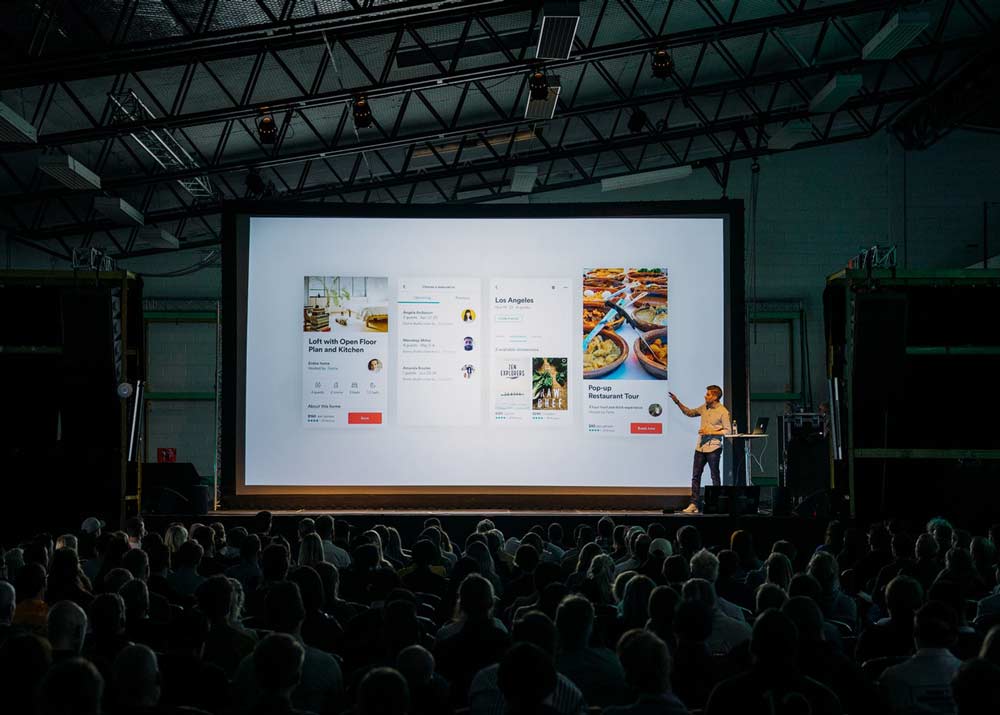![How To Deal With Sensory Overload [9 Tips For Overstimulation]](https://happyrubin.com/wp-content/uploads/2019/12/ik-ben-overprikkeld-150x150.jpg)
Interactive Teaching & Presenting? Brilliant Method & Tips!

In this article you will find the best method with ideas and examples for an interactive presentation. This allows you to involve your audience as much as possible in your presentation or workshop. ‘I know I have to teach interactively, but how do I make my presentation interactive and original?’ Read more…
Contents of this page:
Interactive Presenting | Step 0 of 8 – Always start by making a connection
Before you do anything else, build a connection with the audience. Otherwise you will fall straight to the point. Take a moment to ask how the group is doing and what they have just done.
It’s also nice to introduce yourself if they don’t know you yet. This is called rapport making. If necessary, use this step to briefly mention the topic of your workshop or presentation.
Interactive Presenting | Step 1 of 8 – Introduce your topic with a metaphor

The best way to introduce your presentation or workshop is through a metaphor.
- In this first step you tell a metaphor in which your lessons of today are implicitly hidden . You can also use your metaphor to get your audience into a certain frame of mind in which they are open to your lessons. Use the handy article on metaphors. There you will find a complete step-by-step plan for creating a metaphor.
- Do you tell multiple metaphors, or are there perhaps multiple ‘times and spaces’ (scenes) within your metaphor? Then give each time-and-space (scene) its own anchor on the stage. You plan these locations in advance, and remember that from the audience’s perspective, it should go from left to right chronologically.
- Do you provide training for several days? Then, in addition to metaphors for each lesson, run metaphors throughout the training and close them all in the last half hour of the training. The beginning of these metaphors marks the beginning of the training. The end of these metaphors marks the end of the training. A possible message from the ending metaphor could be that you use the metaphor to make it clear that the participants are not going back home, but that they are going home forward!
Examples of moods that you can put in your metaphor, because they are always useful for training:
- In that case, also put curiosity, openness and receptivity into your metaphor.
- ‘If you do what you have always done, you will get what you have always done. Test something new. That’s what you’re here for. You are invited to participate in the spirit of an explorer, and to discover new territories as an adventurer to make a map of them. Explorers exploring new territory cannot do so if they bring their home city maps with them. If they did, they would quickly get lost and their adventure would be severely limited. The adventurer has his senses fully open to new opportunities, while also being comfortable with unfamiliar territory. ‘
Interactive Presenting | Step 2 of 8 – Provide the explicit frame

You provide a frame for your interactive workshop or presentation, and you can then defend this framework during your workshop.
- Explain what you will be teaching the group today. In other words: what is your intention and your goal? This is the key to providing value in your training: what is the purpose behind the goal? You may want to ask the audience the intention questions at this point to ask the purpose behind the goal of the participants. What is your goal for this training? And beyond that? And behind it? ‘
- You also introduce the planning of the workshop: tell what the parts of your workshop are. Remember to indicate explicitly when questions can be asked. Many questions are solved automatically after participants have practiced themselves. So the best place for questions is at step 7. If someone asks a question while you are working on a part that is before step 7, such as a demonstration, feel free to wave them away: the framework has already been set, and you can safely defend that . ‘I appreciate the intelligence and intention behind the questions. Because of the framework, we will now proceed with… ”“ I saw your question, we’ll get to that in a moment, during the questioning part. ”
- If you want to teach completely inductively, this step can be skipped. This step is desirable for more business contexts.
Interactive Presenting | Step 3 of 8 – Provide real-life examples

This is an essential step for an interactive presentation or workshop. In this step it is important to create recognition . In addition, you create the ‘why’ and the belief of why we should start learning your lessons at all.
Finally, this step has a very different special use: during this step you pay close attention to who in the audience reacts enthusiastically enough to the examples to be chosen to participate in the demonstration (step 4).
- Give examples from your own life where today’s lessons / tools could have been useful. Preferably give at least three so that there is a suitable example for everyone. In the meantime, you calibrate in the audience whether everyone recognizes these examples and is already getting more enthusiastic.
- In the audience, ask which people have experienced similar situations.
- Question at the end: do you think {real-life example} would have liked to use {today’s lessons}? Would this be interesting to learn?
- Summarize the ‘why’ (and the ‘why not’). By doing this you build motivation to want to learn your lessons. Why is it so important or meaningful to learn the lessons that will be discussed in a moment?
Interactive Presenting | Step 4 of 8 – Give a transparent demonstration: show the effect of your lessons!

- It is ideal if you can also show the material you want to teach your audience in practice. A demonstration is ideal for this, if of course it is possible in the time and space you have.
- If your technique or lesson does not lend itself to a demonstration, or if your audience can recognize your lesson in practice, it is always useful to work with cards that you hand out to the audience. Each card contains one (or more) example or part of your technique / teaching material. You ask the audience if they can come up with a similar example or if they can apply the technique by coming up with an example.
- You can also demonstrate examples of your technique / lesson to the audience where they can recognize it. Let’s take the example of where you would present a language technique: the Meta model . Then you could fire parts of the Meta model at the audience so that the audience can recognize what is happening. For example, you would give five examples of the cause-effect pattern: “Peter, you’re smiling, so you enjoy being here.” And then you ask what the audience recognizes in the five examples.
- If you want to demonstrate the lesson material to one of the participants that you want to bring up for this, ask who could use it, instead of ‘Who wants to come? Because then you also have someone who can really benefit from the demonstration of the technology, so that you get more cooperation.
Interactive Presenting | Step 5 of 8 – Create a context for discovery

This is also indispensable in an interactive presentation. Ask questions about the demonstration just conducted and write down the audience’s answers. In this way you put a model of the experience of the group on a flip chart.
- What have we seen and heard?
- What went well?
- What didn’t go perfectly in this demonstration? If a demonstration does not go well, you use it to discover with the audience in which cases it does not work!
- What did you learn? What are the learning points?
- What is the essence of these learning points? What’s important? (What could be deleted?)
- What are important steps of this technique? What did I do first and then after?
- What is the intention (of step X)?
Interactive Presenting | Step 6 of 8 – Offer a well-structured exercise

An exercise is a structured experience. A good, inductive trainer creates experiences. By experiencing it, it enters your nervous system and so you learn the fastest. People will only believe your lessons when they have really experienced it. This is the best proof of the quality of your teaching material!
- Put your exercise on a flip chart and use bullets: step 1: step 2: etc.
- Write as few words and steps as possible on the flipchart. Stick to the gist: What are the most essential steps I take on the flipchart? What can I delete?
It is important to create a safe atmosphere where everything can be said and done. This allows you to get the most out of the exercise. Really encourage people to experiment with each other and let them know how valuable it is and how important it is to trust each other.
Have you found your practice partner? The first thing you do is become aware of the following together: the universe is always organizing. It is always organizing for your success. Including the partners you meet and get. Over and over and over and over to create the perfect conditions for success, including the partners you are with. Acknowledge the partner you are with and ask each other if you are willing to trust each other for the next ten minutes. The other says that he can be trusted: “You can trust me.”
Interactive Presenting | Step 7 of 8 – Clean things up: provide room for questions

- Start with an open question: what did you discover / learn while doing the technique?
- Do ask about the mistakes that have been made. They are incredibly valuable as learning experiences! Encourage and even reward the group for making more mistakes. “I keep track of how many mistakes everyone makes.”
- What will you do different next time?
- After that: are there any questions?
Interactive Presenting | Step 8 of 8 – Generalization: how can these lessons be used in the future (What if …)?

In this dialogue you discover concrete applications of what you have taught your audience. You use, among other things, the wonder question .
- How can these lessons be used in our lives in future situations? Be specific here. What are specific examples you have? What do we need to know? Why should we use these lessons in future situations, and why not?
- If necessary, use the reflection methods .
- Did you cut off the metaphor in step 1 with a cliffhanger (an open loop)? Then close it here again. Was the metaphor already completed in step 1? Generalize the metaphor now into the future or use a new metaphor here.
- Put post-hypnotic suggestions in this metaphor.
- Use the Pavlovian effect to anchor the metaphor of this lesson. This way you can fire this anchor again during the next lesson to connect this lesson to the next lesson.
Read more about working methods for interactive presentation
This interactive teaching method is a form of the inductive method. We also have two valuable articles about interactive presentations and workshops. So also read the article with dozens of presentation tips and the article about the structure of a presentation.

![5 Best Self Care Tips For College Students [#1 Advice]](https://happyrubin.com/wp-content/uploads/2021/09/the-best-self-care-tips-for-college-students-440x264.jpg)
![How To Stick To New Year’s Resolutions: 9 Tips [Smart & Sure Ways]](https://happyrubin.com/wp-content/uploads/2019/12/tips-voor-goede-voornemens-440x264.jpg)
![How To Stop Being So Hard On Yourself [9 Great Tips]](https://happyrubin.com/wp-content/uploads/2019/12/we-moeten-zoveel-van-onszelf-en-anderen-150x150.jpg)

![19 Best Ice Breaker & Get-To-Know-Eachother Games [Fun & Simple]](https://happyrubin.com/wp-content/uploads/2018/02/leukste-ijsbrekers.jpeg)
![Becoming More Social: 41 Tips [Improving Social Skills] [List]](https://happyrubin.com/wp-content/uploads/2018/06/sociale-vaardigheden1.jpeg)
![How to start a conversation with anyone: 15 tips [Making contact]](https://happyrubin.com/wp-content/uploads/2017/08/gesprekstechnieken1.jpeg)
![372 Friend Tag Q&A Questions [Best Friend Quiz]](https://happyrubin.com/wp-content/uploads/2019/05/best-friend-tag-vragen-voorbeelden.jpg)



![Clingy & controlling behavior of partner/date [Extreme examples]](https://happyrubin.com/wp-content/uploads/2020/06/claimerig-gedrag-van-partner-eigenschappen-en-voorbeelden-150x150.jpg)

![How to recognize if a man is in love [Signals & his body language]](https://happyrubin.com/wp-content/uploads/2020/05/verliefd-gedrag-van-mannen-herkennen-150x150.jpg)


![Free will and religion / theology [Verses & Quotes on free will]](https://happyrubin.com/wp-content/uploads/2020/10/religion-on-free-will-quotes-1050x640-1-150x150.jpg)

![Dealing With Setbacks & Hardship [Lessons & Examples]](https://happyrubin.com/wp-content/uploads/2018/11/omgaan-met-tegenslag-tips-hoe-dan.jpeg)
![NLP Agreement Frame: Use these exact sentences [Examples]](https://happyrubin.com/wp-content/uploads/2020/10/agreement-frame-nlp-1125x640-1-440x264.jpeg)
![122 Best Comebacks In Any Situation [Best Examples]](https://happyrubin.com/wp-content/uploads/2020/06/beste-comebacks-technieken-tips-440x264.jpg)
![Using Hypnosis to Stop Smoking [HowTo]](https://happyrubin.com/wp-content/uploads/2020/05/stoppen-met-roken-door-hypnose-150x150.jpg)
![Presuppositions language pattern: meaning & examples [NLP]](https://happyrubin.com/wp-content/uploads/2020/04/wat-zijn-vooronderstellingen-150x150.jpg)
![Peripheral Vision: Meaning & Exercise [Essential Skill]](https://happyrubin.com/wp-content/uploads/2020/04/perifeer-zicht-trainen-tips-150x150.jpg)

![How To Start A Coaching Business [21 Smart Tips]](https://happyrubin.com/wp-content/uploads/2018/11/coachingpraktijk-starten-tips.jpeg)
![How to make dreams come true? [33 tips to realize dreams 100%]](https://happyrubin.com/wp-content/uploads/2018/05/dromen-mijlpalen.jpeg)
![How To Become Rich? 27 Millionaire Tips [Guaranteed To Work]](https://happyrubin.com/wp-content/uploads/2018/01/hoe-kan-ik-rijk-worden.jpeg)
![77 Best Online Marketing Tools [Recommendations] [Also Free]](https://happyrubin.com/wp-content/uploads/2018/08/beste-onlne-marketing-tools-tips.jpeg)
![Complete List Of Virtues & Qualities [Including Explanation]](https://happyrubin.com/wp-content/uploads/2018/12/kernkwaliteiten-uitleg.jpeg)
![Being Attentive: How Do You Do That? [Meaning & 9 Tips]](https://happyrubin.com/wp-content/uploads/2019/05/attent-zijn.jpg)
![Being Conscientious: Meaning Of This Virtue [Explained]](https://happyrubin.com/wp-content/uploads/2018/07/Consciëntieus-persoon.jpg)


![Best Books About Burn-Out [Top 10] [Update 2025]](https://happyrubin.com/wp-content/uploads/2020/06/beste-boeken-over-burnout-lijst-440x264.jpg)
![Best Self-love Books [Top 10] [Update 2025]](https://happyrubin.com/wp-content/uploads/2020/04/beste-boeken-over-zelfliefde-aanraders-440x264.jpg)
![Life changing books: 10 books that change your life [2025 Update]](https://happyrubin.com/wp-content/uploads/2020/03/levensveranderende-boeken-tips-150x150.jpg)
![Top 10 Best Books: Recommendations Per Genre [2025 Update]](https://happyrubin.com/wp-content/uploads/2019/12/best-books-per-genre-150x150.png)
![Best Books On procrastination: Must Reads [List] [2025 Update]](https://happyrubin.com/wp-content/uploads/2019/11/beste-boeken-over-uitstelgedrag-tips-150x150.jpg)
![Joe Dispenza: Events To Attend [2025 & 2026] [All Info]](https://happyrubin.com/wp-content/uploads/2020/02/joe-dispenxa-events-440x264.png)
![Best Online Study Options [Online Education Top List]](https://happyrubin.com/wp-content/uploads/2019/03/best-home-study-options-440x264.png)
![Teachable Review & Experiences 2025 [Bad Online Training Tool?]](https://happyrubin.com/wp-content/uploads/2020/02/Teachable-review-ervaringen-150x150.png)
![Audible Review, Experiences & Special Discount [Scam?]](https://happyrubin.com/wp-content/uploads/2020/01/audible-review-ervaringen-150x150.png)
![Guest Posts Wanted [Free & Always Directly Accepted]](https://happyrubin.com/wp-content/uploads/2019/05/gastbloggen-regels.jpg)
